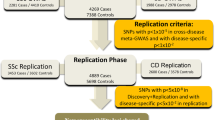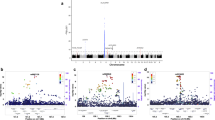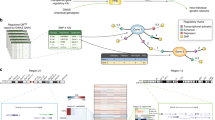Abstract
In a recent study on multiple sclerosis (MS), we observed additive effects and epistatic interactions between variants of four genes that converge to induce T-cell hyperactivity by altering Asn-(N)-linked protein glycosylation: namely, the Golgi enzyme MGAT1, cytotoxic T-lymphocyte antigen 4 (CTLA-4), interleukin-2 receptor-α (IL2RA) and interleukin-7 receptor-α (IL7RA). As the CTLA-4, IL2RA and IL7RA variants are associated with type 1 diabetes (T1D), we examined for joint effects in T1D. Employing a novel conditional logistic regression for family-based data sets, epistatic and additive effects were observed using 1423 multiplex families from the Type 1 Diabetes Genetic Consortium data set. The IL2RA and IL7RA variants had univariate association in MS and T1D, whereas the MGAT1 and CTLA-4 variants associated with only MS or T1D, respectively. However, similar to MS, the MGAT1 variant haplotype interacted with CTLA4 (P=0.03), and a combination of IL2RA and IL7RA (P=0.01). The joint effects of MGAT1, CTLA4, IL2RA, IL7RA and the two interactions using a multiple conditional logistic regression were statistically highly significant (P<5 × 10−10). The MGAT1–CTLA-4 interaction was replicated (P=0.01) in 179 trio families from the Genetics of Kidneys in Diabetes study. These data are consistent with defective N-glycosylation of T cells contributing to T1D pathogenesis.
This is a preview of subscription content, access via your institution
Access options
Subscribe to this journal
Receive 6 digital issues and online access to articles
$119.00 per year
only $19.83 per issue
Buy this article
- Purchase on Springer Link
- Instant access to full article PDF
Prices may be subject to local taxes which are calculated during checkout

Similar content being viewed by others
References
Manolio TA, Collins FS, Cox NJ, Goldstein DB, Hindorff LA, Hunter DJ et al. Finding the missing heritability of complex diseases. Nature 2009; 461: 747–753.
Mkhikian H, Grigorian A, Li CF, Chen HL, Newton B, Zhou RW et al. Genetics and the environment converge to dysregulate N-glycosylation in multiple sclerosis. Nat Commun 2011; 2: 334.
Li CF, Zhou RW, Mkhikian H, Newton BL, Yu Z, Demetriou M . Hypomorphic MGAT5 polymorphisms promote multiple sclerosis cooperatively with MGAT1 and interleukin-2 and 7 receptor variants. J Neuroimmunol 2013; 256: 71–76.
Grigorian A, Mkhikian H, Li CF, Newton BL, Zhou RW, Demetriou M . Pathogenesis of multiple sclerosis via environmental and genetic dysregulation of N-glycosylation. Semin Immunopathol 2012; 34: 415–424.
Demetriou M, Granovsky M, Quaggin S, Dennis JW . Negative regulation of T-cell activation and autoimmunity by Mgat5 N-glycosylation. Nature 2001; 409: 733–739.
Lee SU, Grigorian A, Pawling J, Chen IJ, Gao G, Mozaffar T et al. N-glycan processing deficiency promotes spontaneous inflammatory demyelination and neurodegeneration. J Biol Chem 2007; 282: 33725–33734.
Grigorian A, Lee SU, Tian W, Chen IJ, Gao G, Mendelsohn R et al. Control of T Cell-mediated autoimmunity by metabolite flux to N-glycan biosynthesis. J Biol Chem 2007; 282: 20027–20035.
Grigorian A, Araujo L, Naidu NN, Place D, Choudhury B, Demetriou M . N-acetylglucosamine inhibits T-helper 1 (Th1) / T-helper 17 (Th17) responses and treats experimental autoimmune encephalomyelitis. J Biol Chem 2011; 286: 40133–40141.
Grigorian A, Mkhikian H, Demetriou M . Interleukin-2, Interleukin-7, T cell-mediated autoimmunity, and N-glycosylation. Ann NY Acad Sci 2012; 1253: 49–57.
Zhernakova A, van Diemen CC, Wijmenga C . Detecting shared pathogenesis from the shared genetics of immune-related diseases. Nat Rev Genet 2009; 10: 43–55.
Cotsapas C, Voight BF, Rossin E, Lage K, Neale BM, Wallace C et al. Pervasive sharing of genetic effects in autoimmune disease. PLoS Genet 2011; 7: e1002254.
Smyth DJ, Plagnol V, Walker NM, Cooper JD, Downes K, Yang JHM et al. Shared and distinct genetic variants in type 1 diabetes and celiac disease. New Engl J Med 2008; 359: 2767–2777.
Sirota M, Schaub MA, Batzoglou S, Robinson WH, Butte AJ . Autoimmune disease classification by inverse association with snp alleles. PLoS Genet 2009; 5: e1000792.
Todd JA . Etiology of type 1 diabetes. Immunity 2010; 32: 457–467.
Maier LM, Lowe CE, Cooper J, Downes K, Anderson DE, Severson C et al. IL2RA genetic heterogeneity in multiple sclerosis and type 1 diabetes susceptibility and soluble interleukin-2 receptor production. PLoS Genet 2009; 5: e1000322.
Self SG, Longton G, Kopecky KJ, Liang KY . On estimating HLA/disease association with application to a study of aplastic anemia. Biometrics 1991; 47: 53–61.
Schaid DJ, Sommer SS . Genotype relative risks: methods for design and analysis of candidate-gene association studies. Am J Hum Genet 1993; 53: 1114–1126.
Cordell HJ, Clayton DG . A unified stepwise regression procedure for evaluating the relative effects of polymorphisms within a gene using case/control or family data: application to HLA in type 1 diabetes. Am J Hum Genet 2002; 70: 124–141.
Kotti S, Bickeboller H, Clerget-Darpoux F . Strategy for detecting susceptibility genes with weak or no marginal effect. Hum Hered 2007; 63: 85–92.
Yu ZX, Deng L . Pseudosibship methods in the case-parents design. Stat Med 2011; 30: 3236–3251.
Pociot F, Akolkar B, Concannon P, Erlich HA, Julier C, Morahan G et al. Genetics of type 1 diabetes: what's next? Diabetes 2010; 59: 1561–1571.
Santiago JL, Alizadeh BZ, Martinez A, Espino L, de la Calle H, Fernandez-Arquero M et al. Study of the association between the CAPSL-IL7R locus and type 1 diabetes. Diabetologia 2008; 51: 1653–1658.
Mueller PW, Rogus JJ, Cleary PA, Zhao Y, Smiles AM, Steffes MW et al. Genetics of Kidneys in Diabetes (GoKinD) study: a genetics collection available for identifying genetic susceptibility factors for diabetic nephropathy in type 1 diabetes. J Am Soc Nephrol 2006; 17: 1782–1790.
Zhao H, Zhang S, Merikangas KR, Trixler M, Wildenauer DB, Sun F et al. Transmission/disequilibrium tests using multiple tightly linked markers. Am J Hum Genet 2000; 67: 936–946.
Allen AS, Satten GA . Statistical models for haplotype sharing in case-parent trio data. Hum Hered 2007; 64: 35–44.
Zhang S, Sha Q, Chen HS, Dong J, Jiang R . Transmission/disequilibrium test based on haplotype sharing for tightly linked markers. Am J Hum Genet 2003; 73: 566–579.
Van der Meulen MA, te Meerman GJ . Haplotype sharing analysis in affected individuals from nuclear families with at least one affected offspring. Genet Epidemiol 1997; 14: 915–920.
Dudbridge F, Koeleman BP, Todd JA, Clayton DG . Unbiased application of the transmission/disequilibrium test to multilocus haplotypes. Am J Hum Genet 2000; 66: 2009–2012.
Knapp M, Becker T . Family-based association analysis with tightly linked markers. Hum Hered 2003; 56: 2–9.
Fan R, Knapp M, Wjst M, Zhao C, Xiong M . High resolution T2 association tests of complex diseases based on family data. Ann Hum Genet 2005; 69: 187–208.
Chapman JM, Cooper JD, Todd JA, Clayton DG . Detecting disease associations due to linkage disequilibrium using haplotype tags: A class of tests and the determinants of statistical power. Hum Hered 2003; 56: 18–31.
Zhang Z, Zhang S, Sha Q . A multi-marker test based on family data in genome-wide association study. BMC Genet 2007; 8: 65.
Shi M, Umbach DM, Weinberg CR . Identification of risk-related haplotypes with the use of multiple SNPs from nuclear families. Am J Hum Genet 2007; 81: 53–66.
Lee WC . Testing for candidate gene linkage disequilibrium using a dense array of single nucleotide polymorphisms in case-parents studies. Epidemiology 2002; 13: 545–551.
Cattaert T, Urrea V, Naj AC, De Lobel L, De Wit V, Fu M et al. FAM-MDR: a flexible family-based multifactor dimensionality reduction technique to detect epistasis using related individuals. PLoS One 2010; 5: e10304.
Yu Z, Wang S . Contrasting linkage disequilibrium as a multilocus family-based association test. Genet Epidemiol 2011; 35: 487–498.
Acknowledgements
We thank the National Institute of Diabetes and Digestive and Kidney Diseases for providing access to the T1DGC and GoKinD DNA samples. Research was supported in part by grant R01HG004960 from the National Human Genome Research Institute to ZY and grant R01AI082266 from the National Institute of Allergy and Infectious Diseases to MD.
Author information
Authors and Affiliations
Corresponding author
Ethics declarations
Competing interests
The authors declare no conflict of interest.
Rights and permissions
About this article
Cite this article
Yu, Z., Li, C., Mkhikian, H. et al. Family studies of type 1 diabetes reveal additive and epistatic effects between MGAT1 and three other polymorphisms. Genes Immun 15, 218–223 (2014). https://doi.org/10.1038/gene.2014.7
Received:
Revised:
Accepted:
Published:
Issue Date:
DOI: https://doi.org/10.1038/gene.2014.7
Keywords
This article is cited by
-
Application and Effectiveness of Chinese Medicine in Regulating Immune Checkpoint Pathways
Chinese Journal of Integrative Medicine (2023)
-
Integrated glycomics and genetics analyses reveal a potential role for N-glycosylation of plasma proteins and IgGs, as well as the complement system, in the development of type 1 diabetes
Diabetologia (2023)
-
N-glycosylation bidirectionally extends the boundaries of thymocyte positive selection by decoupling Lck from Ca2+ signaling
Nature Immunology (2014)



